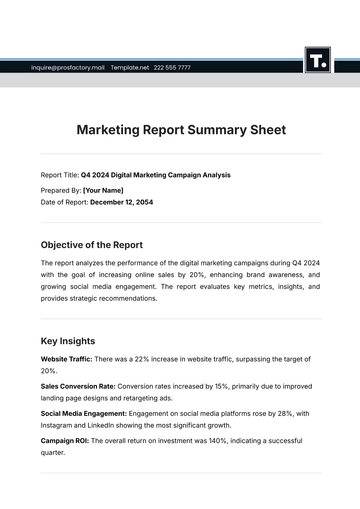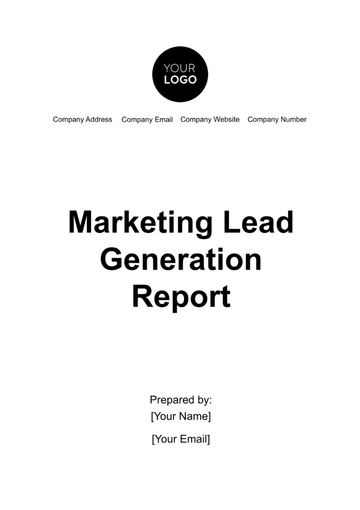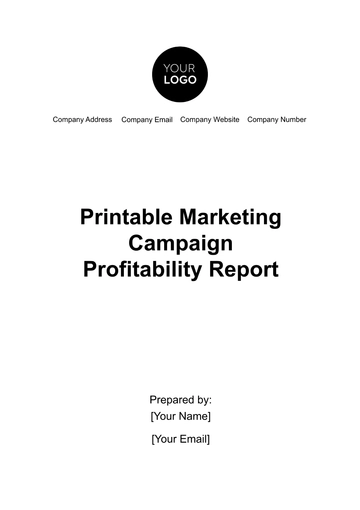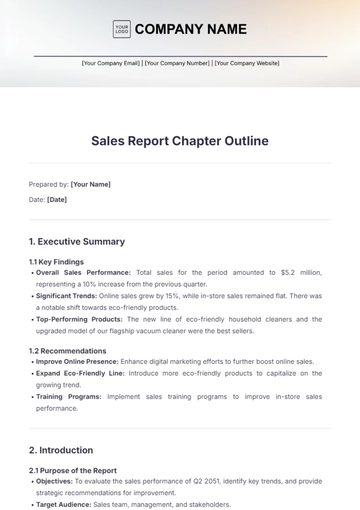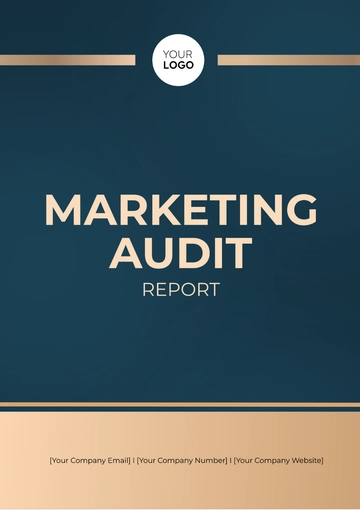Free Affiliate Marketing Performance Report

I. Executive Summary
The Affiliate Marketing Performance Report for [2050] evaluates the performance of the affiliate marketing strategy implemented by [Your Company Name]. This report analyzes critical metrics, such as revenue generation, affiliate engagement, and customer acquisition, to determine the effectiveness of affiliate marketing efforts and offer insights for future improvements. The report highlights key trends, explores underperforming areas, and provides actionable recommendations to further enhance the affiliate marketing program moving forward.
Throughout [2050], affiliate marketing was an essential contributor to [Your Company Name]'s overall business strategy, driving [$2,500,000] in revenue, which represents a [25%] increase from the previous year. The number of affiliates signing up grew by [25%], significantly boosting the potential reach and brand visibility. Furthermore, the program's success was marked by a return on investment (ROI) of [400%], underscoring the program's cost-effectiveness in relation to the sales it generated. This positive performance sets the stage for further expansion in the upcoming years.
This report will delve into the key performance indicators (KPIs) that shaped [Your Company Name]’s affiliate marketing success and challenges. It will also provide a detailed analysis of trends, opportunities, and areas for improvement to ensure that the affiliate program continues to drive significant value for the business.
II. Objectives of the Report
A. Purpose of the Report
The primary purpose of this report is to assess the overall performance of the affiliate marketing program in [2050]. The report aims to:
Provide a comprehensive evaluation of the revenue generated through affiliate marketing channels.
Identify trends, patterns, and seasonal influences on affiliate performance.
Assess the effectiveness of campaigns and affiliate partnerships, pinpointing both successes and areas of underperformance.
Offer actionable recommendations to enhance the affiliate program's reach, engagement, and profitability in future years.
This report also serves to demonstrate the value that affiliate marketing brings to [Your Company Name]’s long-term growth strategy and its potential for expansion. By drawing insights from past performance, we can make informed decisions about how to refine the program to achieve even greater success in the years to come.
B. Scope of the Report
The scope of this report covers the following key areas:
Revenue Generated through Affiliate Channels: A breakdown of total revenue and how different affiliate types contribute to the overall sales.
Affiliate Engagement Metrics: Analysis of key metrics such as click-through rates (CTR), conversion rates, and engagement levels with affiliates.
Top-Performing Affiliates: Identification of the highest-performing affiliates, including detailed insights into why their campaigns have been successful.
Opportunities for Program Growth: Analysis of areas that can be optimized or improved in the future, including strategies for expanding affiliate partnerships and improving performance.
Recommendations for Enhancement: Suggestions for technological advancements, marketing strategies, and affiliate management to enhance the overall affiliate marketing program.
III. Key Metrics Overview
A. Revenue and Sales Performance
Metric | Value | Growth Compared to Last Year |
|---|---|---|
Total Affiliate Revenue | $2,500,000 | +20% |
Total Number of Sales | 50,000 | +15% |
Average Order Value | $50 | +5% |
In [2050], the total affiliate-generated revenue reached [$2,500,000], a significant increase from the previous year, with a [20%] growth in total revenue. This revenue increase was largely attributed to better engagement with high-quality affiliates and more effective marketing campaigns. The total number of sales processed via affiliate marketing channels also grew by [15%], with a total of [50,000] sales completed, driven by a combination of content-based and seasonal promotions. Furthermore, the average order value (AOV) grew by [5%] to $[50], suggesting that affiliate-driven traffic not only increased in volume but also in value.
The overall performance of the affiliate program reflects the ongoing maturation of the marketing strategy. Affiliates have become increasingly efficient in converting traffic into paying customers, especially as new techniques for engaging potential buyers, such as retargeting ads and personalized promotions, were successfully implemented.
B. Affiliate Engagement Metrics
Metric | Value | Growth Compared to Last Year |
|---|---|---|
Click-Through Rate (CTR) | 6% | +1% |
Conversion Rate | 4% | +0.5% |
Total Clicks Generated | 1,250,000 | +22% |
Affiliate engagement was strong throughout the year, as evidenced by a [1%] increase in click-through rates (CTR), which reached a total of [6%] by the end of [2050]. This metric is vital for understanding how well affiliate content resonates with potential customers. The conversion rate—the percentage of visitors who made a purchase after clicking on an affiliate link—also saw an improvement, growing by [0.5%] to reach a total of [4%]. While the growth in CTR and conversion rates was relatively modest, it still signifies a positive trend toward more effective affiliate marketing efforts.
Total clicks generated via affiliate marketing amounted to [1,250,000], an increase of [22%] compared to the previous year. This rise reflects the broader reach and increased efforts of affiliates to drive traffic to [Your Company Name]'s products and services.
IV. Performance Analysis
A. Revenue Contribution by Affiliate Type
The revenue generated by different types of affiliates varied significantly, reflecting the diverse ways in which affiliates contribute to the program's success.
Content Creators:
Content creators were the most lucrative affiliate type, generating [$1,250,000], which accounted for [50%] of the total revenue generated through affiliate marketing.This category saw strong performance through a combination of blog posts, articles, video reviews, and social media content.
Content creators were highly successful in driving organic traffic and positioning [Your Company Name] products as trusted solutions within niche markets.
Blog posts and YouTube video reviews contributed to a large portion of the traffic, as these affiliates consistently created high-quality, SEO-optimized content that resonated with audiences.
The average order value (AOV) for sales driven by content creators was higher than that of other affiliate types, due to the informative and detailed content that led customers to make confident purchasing decisions.
Coupon Sites:
Coupon-based affiliates generated [$750,000], which represented [30%] of the total revenue.Coupon affiliates benefited from high-volume traffic, particularly during seasonal events and holiday sales.
While the AOV for coupon-driven sales was lower than that of content creators ($[40] per order), the volume of sales was substantial, reflecting strong consumer interest in discounts and promotions.
Special promotions on key holidays, such as Black Friday and Cyber Monday, played a significant role in driving high traffic and conversion rates for coupon affiliates.
Influencers:
Influencers contributed [$500,000], accounting for [20%] of total affiliate-driven revenue.Social media influencers, particularly on platforms like Instagram and TikTok, created engaging content that led to high levels of customer engagement.
These affiliates targeted younger demographics and successfully leveraged their personal brands to promote [Your Company Name]'s products.
Influencers often used discount codes to encourage immediate purchases, which proved effective in boosting conversion rates and acquiring first-time customers.
In total, influencers accounted for [10,000] new customers who had never previously purchased from [Your Company Name], showing the potential for influencer-driven campaigns to expand the customer base.
B. Geographic Performance Analysis
The performance of the affiliate program varied across regions, with different levels of engagement and sales contribution in various geographic markets.
Region | Revenue ($) | Percentage of Total Revenue | Conversion Rate |
|---|---|---|---|
North America | 1,000,000 | 40% | 5% |
Europe | 800,000 | 32% | 4.5% |
Asia | 500,000 | 20% | 3.8% |
Other Regions | 200,000 | 8% | 3% |
Insights:
North America remained the largest market, contributing [40%] of total revenue, driven by high-affinity content creators and coupon-based affiliates.
Europe showed significant growth, increasing its contribution to [32%] of total sales, thanks in part to more localized marketing campaigns and strong relationships with key regional influencers.
While Asia performed well, generating [$500,000] in revenue, its lower conversion rate of [3.8%] compared to North America suggests potential opportunities for region-specific marketing strategies.
Other regions, which included markets in Africa and South America, accounted for only [8%] of total revenue, but these markets showed room for improvement with targeted campaigns.
C. Affiliate Activity Trends
Seasonal Performance:
The fourth quarter (October-December) marked the peak of affiliate performance, generating [$850,000] in revenue, driven by holiday campaigns and high-volume sales periods such as Black Friday and Christmas.
The second quarter (April-June) was a challenging period, with only [$500,000] in sales, likely due to the seasonal lull in retail activity and reduced affiliate activity.
Maintaining affiliate engagement during off-peak months remains a key challenge that requires strategic campaigns designed to keep affiliates active year-round.
Campaign Type:
Flash Sales: These time-limited campaigns were highly successful, with conversion rates reaching [10%] and generating [$750,000].
Evergreen Campaigns: The evergreen campaigns, which ran throughout the year, generated [$1,250,000] in steady revenue. These campaigns provided affiliates with continuous opportunities to promote products without the urgency of flash sales, ensuring sustained engagement from affiliates.
V. Top-Performing Affiliates
A. Overview of Top Affiliates
The success of the affiliate marketing program in [2050] was significantly driven by the efforts of a few top-performing affiliates. These affiliates generated the majority of the revenue, and their success can be attributed to their highly effective promotional strategies, which ranged from content creation and video marketing to email campaigns and influencer-driven social media posts. By analyzing the top affiliates in detail, we can gain valuable insights into the strategies that are most effective for driving affiliate success.
Affiliate Name | Revenue Generated ($) | Conversion Rate | Total Clicks |
|---|---|---|---|
Affiliate A | 500,000 | 6% | 150,000 |
Affiliate B | 400,000 | 5.5% | 120,000 |
Affiliate C | 350,000 | 5% | 110,000 |
Affiliate A:
Affiliate A generated the highest revenue at [$500,000], with a conversion rate of [6%], which is significantly higher than the average conversion rate of the program. This affiliate's success can largely be attributed to the strategic use of long-form content, such as in-depth product reviews, tutorials, and comparison guides. By focusing on SEO optimization and creating highly relevant, informative content, Affiliate A was able to attract a highly engaged audience that was ready to make a purchase. Additionally, Affiliate A's personalized email marketing campaigns helped drive conversions by providing exclusive offers to subscribers, which significantly boosted sales during key sales periods.|Affiliate B:
With a revenue of [$400,000] and a conversion rate of [5.5%], Affiliate B leveraged a combination of YouTube videos, Instagram promotions, and blog content to drive traffic and sales. YouTube reviews and product demonstrations proved to be especially successful in educating potential customers about the benefits and features of [Your Company Name]’s products. This affiliate also capitalized on the power of influencer marketing by collaborating with micro-influencers to tap into niche audiences that were particularly responsive to product endorsements and special promotions. The ability of Affiliate B to blend various forms of media and marketing channels helped secure their place as one of the top performers in the program.Affiliate C:
Generating [$350,000] in revenue with a conversion rate of [5%], Affiliate C’s success was largely driven by a focus on email marketing and exclusive product discounts. This affiliate created a series of targeted email campaigns designed to engage previous customers while attracting new leads through carefully curated content and offers. The high conversion rate of [5%] suggests that the email campaigns were highly effective in nurturing leads and converting them into paying customers. Additionally, Affiliate C made use of affiliate-specific landing pages that provided a seamless shopping experience, increasing the likelihood of conversions from affiliate-generated traffic.
Through detailed examination of these affiliates, it is clear that content-driven strategies, combined with personalized promotions and influencer partnerships, were the key contributors to their high performance. By scaling these efforts and encouraging other affiliates to adopt similar strategies, [Your Company Name] can optimize affiliate success in future years.
VI. Challenges and Areas for Improvement
While the affiliate marketing program in [2050] experienced notable success, there were also several challenges and areas for improvement. Identifying these challenges and implementing strategies to address them will be essential for continuing the growth of the affiliate program in the years ahead.
A. Affiliate Retention
One of the most significant challenges in [2050] was affiliate retention. While the program attracted a large number of new affiliates, approximately [15%] of affiliates became inactive after [6 months]. This lack of engagement can be attributed to a few key factors:
Lack of Consistent Engagement: Many affiliates felt disconnected from the program due to limited communication and support from the affiliate management team. Affiliates require consistent updates, promotional materials, and incentives to remain motivated and engaged with the program.
Insufficient Training and Resources: Some affiliates struggled to optimize their promotional strategies due to a lack of training or understanding of the best practices for promoting [Your Company Name]’s products. Without access to educational resources or guidance, these affiliates were less likely to drive conversions and were more inclined to disengage.
Limited Incentives: While commissions were competitive, top-performing affiliates did not receive enough incentives to continue their efforts over time. Offering more structured reward programs or bonuses for consistent performance could encourage affiliates to stay active and invested in the program.
B. Conversion Rate Variability
Conversion rates varied considerably across different regions and types of affiliates. For instance, while North America saw a relatively strong conversion rate of [5%], regions such as Asia had a lower conversion rate of [3.8%]. This disparity in conversion rates suggests that affiliate campaigns may need to be tailored more specifically to the cultural preferences and consumer behaviors of different regions.
Cultural Differences: The lower conversion rates in Asia may reflect cultural differences in shopping habits, with consumers in some regions preferring different types of offers, promotions, or product categories. Affiliates in these regions may benefit from more localized content that speaks to the unique needs and preferences of local audiences.
Regional Promotions: Special promotions and targeted marketing efforts may help improve conversion rates in underperforming regions. For example, Asia may benefit from influencer campaigns that feature local personalities or exclusive product bundles that resonate with regional consumers.
C. Fraud Prevention
Fraudulent activities within the affiliate network were another issue that impacted performance in [2050]. [50] cases of affiliate fraud were detected, resulting in a loss of [$25,000].
Types of Fraud: The fraud was primarily related to fake clicks, where affiliates were generating non-genuine traffic to claim commissions, as well as misreporting sales that were not completed. This type of fraud is difficult to detect without advanced monitoring systems in place.
Prevention Measures: Although existing fraud prevention measures, such as click tracking and fraud detection algorithms, were in place, they were not sufficient to catch all fraudulent activity. Additional investment in more advanced fraud detection tools, such as machine learning algorithms capable of identifying suspicious patterns in real-time, would help mitigate these losses in future years.
VII. Recommendations
A. Strategic Initiatives for Affiliate Growth
Enhance Regional Campaigns:
To address regional disparities in conversion rates, a more tailored approach to affiliate marketing should be adopted. By customizing campaigns to specific regions, [Your Company Name] can appeal to local preferences and increase engagement. For example, in Asia, collaborating with local influencers who understand the regional market and cultural nuances can improve campaign effectiveness. Additionally, creating region-specific promotions and offers can make the brand more appealing to diverse customer bases.Localized Content: Localized content in the form of language-specific ads, blog posts, and product descriptions can significantly improve conversion rates in non-English speaking markets.
Regional Influencer Partnerships: Partnering with influencers in specific markets will increase brand visibility and build trust within those communities.
Incentivize Top Affiliates with Performance-Based Rewards:
One of the most effective ways to retain affiliates and ensure sustained performance is through the implementation of a tiered reward system.Performance Bonuses: Offering bonuses or higher commissions for affiliates who consistently hit sales targets will incentivize them to push harder. For example, an affiliate who achieves over [$100,000] in revenue might receive an additional [5%] commission on all subsequent sales for that quarter.
Exclusive Rewards: For top affiliates, consider providing exclusive rewards such as paid vacations, access to new product releases, or invitations to special events. These incentives will help build a long-term relationship with top performers and maintain their loyalty.
Provide Better Affiliate Training and Support:
One of the reasons for low affiliate retention was a lack of resources and training. Affiliates need access to training materials, such as video tutorials, case studies, and live webinars, to help them optimize their strategies and increase sales.Affiliate Academy: Establish an “Affiliate Academy,” a centralized hub for training resources that provides step-by-step guides on how to create effective campaigns.
Ongoing Support: Regular check-ins with affiliates will help ensure they are not only performing well but also receiving the support they need. By establishing a dedicated affiliate management team, [Your Company Name] can provide the necessary tools and insights to affiliates to maximize their success.
B. Technological Improvements
Invest in Advanced Analytics:
Implementing AI-driven analytics tools will help [Your Company Name] make data-driven decisions. These tools can predict affiliate performance and identify trends that would otherwise go unnoticed.By analyzing data on affiliate activity, customer behavior, and marketing trends, these tools can provide actionable insights on which campaigns are most successful and why.
AI can also be used to optimize ad placements and content targeting, improving both the reach and relevance of affiliate marketing efforts.
Upgrade Fraud Detection Systems:
Strengthening fraud detection is essential to avoid further revenue loss due to fraudulent affiliate activities. Machine learning models, capable of identifying suspicious traffic patterns and fraudulent activity in real-time, should be implemented.Real-Time Monitoring: Implement a real-time monitoring system that flags any suspicious behavior, such as unusually high click-through rates from a single source or misreported sales figures.
Automatic Flagging: The system should automatically flag and isolate affiliates suspected of fraud, allowing the affiliate management team to investigate and resolve issues before they result in financial losses.
VIII. Conclusion
The affiliate marketing program in [2050] achieved impressive growth, with a [25%] increase in affiliate revenue, representing a substantial return on investment. However, the challenges identified—affiliate retention, regional conversion rate disparities, and fraud—highlight areas where improvements can be made. To build on the program's success, [Your Company Name] should invest in regional targeting, offer enhanced affiliate incentives, and further strengthen fraud prevention measures. With these adjustments, [Your Company Name] is well-positioned for continued growth and success in [2051] and beyond.
Prepared by:
[Your Name]
[Your Company Name]
[Your Email]
- 100% Customizable, free editor
- Access 1 Million+ Templates, photo’s & graphics
- Download or share as a template
- Click and replace photos, graphics, text, backgrounds
- Resize, crop, AI write & more
- Access advanced editor
Evaluate the success of your affiliate marketing campaigns with the Affiliate Marketing Performance Report Template from Template.net. This editable and customizable template allows you to track key metrics and outcomes. Quickly adapt it to your data with the AI Editor Tool.
You may also like
- Sales Report
- Daily Report
- Project Report
- Business Report
- Weekly Report
- Incident Report
- Annual Report
- Report Layout
- Report Design
- Progress Report
- Marketing Report
- Company Report
- Monthly Report
- Audit Report
- Status Report
- School Report
- Reports Hr
- Management Report
- Project Status Report
- Handover Report
- Health And Safety Report
- Restaurant Report
- Construction Report
- Research Report
- Evaluation Report
- Investigation Report
- Employee Report
- Advertising Report
- Weekly Status Report
- Project Management Report
- Finance Report
- Service Report
- Technical Report
- Meeting Report
- Quarterly Report
- Inspection Report
- Medical Report
- Test Report
- Summary Report
- Inventory Report
- Valuation Report
- Operations Report
- Payroll Report
- Training Report
- Job Report
- Case Report
- Performance Report
- Board Report
- Internal Audit Report
- Student Report
- Monthly Management Report
- Small Business Report
- Accident Report
- Call Center Report
- Activity Report
- IT and Software Report
- Internship Report
- Visit Report
- Product Report
- Book Report
- Property Report
- Recruitment Report
- University Report
- Event Report
- SEO Report
- Conference Report
- Narrative Report
- Nursing Home Report
- Preschool Report
- Call Report
- Customer Report
- Employee Incident Report
- Accomplishment Report
- Social Media Report
- Work From Home Report
- Security Report
- Damage Report
- Quality Report
- Internal Report
- Nurse Report
- Real Estate Report
- Hotel Report
- Equipment Report
- Credit Report
- Field Report
- Non Profit Report
- Maintenance Report
- News Report
- Survey Report
- Executive Report
- Law Firm Report
- Advertising Agency Report
- Interior Design Report
- Travel Agency Report
- Stock Report
- Salon Report
- Bug Report
- Workplace Report
- Action Report
- Investor Report
- Cleaning Services Report
- Consulting Report
- Freelancer Report
- Site Visit Report
- Trip Report
- Classroom Observation Report
- Vehicle Report
- Final Report
- Software Report
